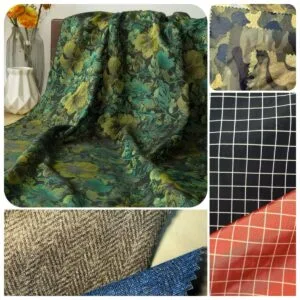
Outdoor fabrics are designed to withstand the elements while maintaining functionality, durability, and aesthetic appeal. Used in a variety of applications ranging from outdoor furniture to adventure gear, these textiles are crafted to meet the demands of challenging environments. In this article, we will explore the key features and advantages of outdoor fabrics, shedding light on why they are an essential component in outdoor settings.
1. Key Features of Outdoor Fabrics
1.1 Weather Resistance
Outdoor fabrics are engineered to resist harsh weather conditions such as rain, sun, wind, and snow. They often feature:
- Waterproofing: Many outdoor fabrics are treated with coatings or membranes to repel water, ensuring that they remain dry and functional even during heavy rain.
- UV Protection: Prolonged exposure to sunlight can degrade standard fabrics. Outdoor textiles often incorporate UV-resistant treatments, preventing fading and weakening caused by ultraviolet rays.
- Wind Resistance: Dense weaves and advanced coatings help these fabrics act as effective barriers against strong winds.
1.2 Durability
One of the standout characteristics of outdoor fabrics is their exceptional durability. Materials such as polyester, acrylic, and solution-dyed fibers are commonly used because they resist:
- Abrasion: Withstand frequent use and friction.
- Tearing: Maintain integrity even under significant stress.
- Pilling: Maintain a smooth texture over time.
1.3 Breathability
While weather resistance is essential, breathability ensures comfort. Advanced outdoor fabrics strike a balance by allowing air and moisture vapor to pass through while keeping water and wind out. This feature is especially important for outdoor clothing and tents.
1.4 Stain and Mold Resistance
Outdoor environments can expose fabrics to dirt, spills, and moisture, creating conditions for mold and mildew growth. Outdoor fabrics are often treated with:
- Stain-Resistant Coatings: To repel spills and make cleaning easier.
- Antimicrobial Treatments: To prevent the growth of mold, mildew, and bacteria.
1.5 Flexibility and Lightweight Design
Despite their strength, many outdoor fabrics are designed to be lightweight and flexible, enhancing their usability in applications like clothing, backpacks, and collapsible structures. They allow ease of movement and are easy to transport.
2. Advantages of Outdoor Fabrics
2.1 Versatility
Outdoor fabrics are used in a wide range of applications, including:
- Outdoor Furniture: Cushions, umbrellas, and covers that withstand sun and rain.
- Adventure Gear: Tents, sleeping bags, and backpacks designed for extreme conditions.
- Clothing: Jackets, pants, and hats for hiking, skiing, and other outdoor activities.
- Marine Use: Boat covers, sails, and upholstery resistant to saltwater and sun exposure.
2.2 Longevity
The durability of outdoor fabrics translates into long-lasting products. Investing in high-quality outdoor textiles reduces the frequency of replacements, making them cost-effective in the long term.
2.3 Aesthetic Appeal
Outdoor fabrics are available in a wide variety of colors, patterns, and textures. This versatility allows designers to create visually appealing products that align with both functional and aesthetic requirements. For example, outdoor furniture can be as stylish as indoor pieces while being more resilient.
2.4 Low Maintenance
Outdoor fabrics are designed for easy care. Most stains can be wiped clean with water and mild soap, and their resistance to mold and mildew reduces the need for frequent washing. This feature is particularly beneficial for busy households and commercial applications.
2.5 Eco-Friendly Options
With increasing environmental awareness, many outdoor fabrics are now made from recycled materials or feature eco-friendly production methods. These fabrics reduce waste and carbon footprints while maintaining performance and durability.
3. Types of Outdoor Fabrics
3.1 Polyester
Polyester is a popular choice for outdoor applications due to its strength, weather resistance, and affordability. It is often used in:
- Umbrellas and awnings.
- Outdoor furniture covers.
- Lightweight jackets and backpacks.
3.2 Acrylic
Acrylic fabrics are known for their UV resistance and color retention. They are commonly found in:
- Cushions and upholstery.
- Marine applications like boat covers.
3.3 Nylon
Nylon is lightweight, strong, and resistant to abrasion, making it ideal for:
- Outdoor clothing and gear.
- Tents and sleeping bags.
3.4 Canvas
Canvas is a natural or blended fabric that offers durability and a classic aesthetic. It is often treated to enhance water and UV resistance and is used in:
- Awnings and tarps.
- Heavy-duty backpacks and duffel bags.
3.5 Solution-Dyed Fabrics
Solution-dyed fabrics incorporate color pigments during the fiber production process, ensuring deep, long-lasting color that resists fading. These fabrics are used in high-end outdoor furniture and shading systems.
4. Innovations in Outdoor Fabrics
4.1 Smart Fabrics
The integration of technology into outdoor textiles is a growing trend. Examples include:
- Temperature-Regulating Fabrics: Adjust to the wearer’s body temperature.
- Moisture-Sensing Materials: Indicate when fabrics are wet and need to dry.
- Solar-Powered Fabrics: Generate electricity to charge small devices.
4.2 Sustainable Materials
The use of biodegradable and recycled materials is reshaping the outdoor fabric industry. Fabrics like recycled polyester and bio-based coatings offer high performance with a reduced environmental impact.
4.3 Enhanced Coatings and Finishes
Advanced coatings now provide outdoor fabrics with added features such as:
- Flame Resistance: Essential for camping gear and safety applications.
- Self-Cleaning Properties: Use nanotechnology to repel dirt and liquids.
5. Challenges in Outdoor Fabric Production
While outdoor fabrics offer numerous benefits, their production and use come with challenges:
- Environmental Impact: The manufacturing process for synthetic materials can be energy-intensive and polluting. Companies are addressing this through sustainable practices.
- Cost: High-performance outdoor fabrics can be expensive, limiting their accessibility.
- Complex Maintenance: While generally low maintenance, improper care (e.g., exposure to harsh chemicals) can degrade protective coatings.
6. Conclusion
Outdoor fabrics are a cornerstone of modern design and functionality, offering unparalleled performance in challenging environments. Their weather resistance, durability, and versatility make them indispensable for outdoor furniture, clothing, and gear. As technology and sustainability efforts advance, outdoor fabrics continue to evolve, providing solutions that cater to both consumer needs and environmental concerns. Investing in high-quality outdoor fabrics ensures long-term satisfaction, proving that these textiles are not just practical but also a worthwhile investment.

